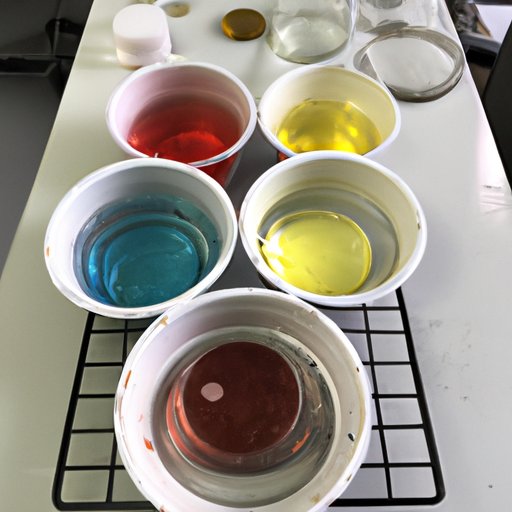Introduction
In the world of science, understanding the definitions and implications of different terms is essential for proper experimentation and research. One term that is often discussed and researched is ‘heterogeneous’, which has a unique meaning in the context of science. To begin, it is important to define what heterogeneous means in science.

Definition of Heterogeneous in Science
Heterogeneous is a term used to describe something that consists of two or more components that are not alike. In other words, it is a mix of two or more dissimilar elements. This term is often used in relation to another term, homogeneous, which is used to describe a uniform mixture of components. A good example of this is a solution, which is a homogenous mixture of two or more substances that are evenly distributed throughout the mixture.

Overview of Homogeneous and Heterogeneous in Science
To further understand what heterogeneous means in science, it is important to explore the differences between homogeneous and heterogeneous mixtures. A homogeneous mixture is one in which all of the components are evenly distributed throughout the mixture. An example of this is salt water, which is composed of salt and water molecules that are evenly dispersed. On the other hand, a heterogeneous mixture is one in which the components are not evenly distributed throughout the mixture. An example of this is oil and water, which are two distinct components that do not mix together.
Exploring Heterogeneous Mixtures in Science
Now that we have explored the basic definition of heterogeneous in science, let’s take a look at what a heterogeneous mixture is and how it differs from a homogeneous mixture.
What is a Heterogeneous Mixture?
A heterogeneous mixture is a combination of two or more distinct components that are not evenly distributed throughout the mixture. The components of a heterogeneous mixture can vary in size, shape, color, texture, and density. For example, a glass of iced tea is a heterogeneous mixture because the ice cubes, tea leaves, and sugar are all distinct components that are not evenly dispersed throughout the mixture.
Examining the Components of Heterogeneous Mixtures
The components of a heterogeneous mixture can be anything from solid particles to liquids or gases. For example, a soil sample may contain a variety of components such as sand, clay, silt, and organic matter. Each of these components can be identified by their distinct physical properties.
Investigating How Heterogeneous Mixtures Differ from Homogeneous Mixtures
As discussed earlier, a homogeneous mixture is one in which all of the components are evenly distributed throughout the mixture. The components of a homogeneous mixture are usually not visible to the naked eye. Examples of homogeneous mixtures include air, salt water, and sugar solution. On the other hand, the components of a heterogeneous mixture are usually visible to the naked eye. Examples of heterogeneous mixtures include soil, salad dressing, and concrete.

The Role of Heterogeneity in Science
Understanding the role of heterogeneity in science is essential for conducting accurate experiments and research. Let’s take a look at how heterogeneity impacts scientific experiments and the benefits it provides to science.
Exploring the Impact of Heterogeneity on Scientific Experiments
Heterogeneity can have a significant impact on scientific experiments. For example, if a researcher is conducting an experiment to measure the rate of diffusion of a substance in a heterogeneous mixture, the results could be skewed due to the uneven distribution of the components. Similarly, if a researcher is trying to measure the solubility of a substance in a heterogeneous mixture, it could be difficult to get an accurate result due to the varying composition of the mixture.
Investigating the Benefits of Heterogeneity to Science
Despite the challenges posed by heterogeneity, it can also provide a number of benefits to science. For example, heterogeneity can help researchers gain a better understanding of how different components interact with each other. Additionally, heterogeneity can provide valuable insight into the behavior of complex systems. According to a study conducted by the University of Edinburgh, “Heterogeneity can lead to new insights into the behavior of complex systems, and can even be beneficial to them.”
Types of Heterogeneity in Science
Heterogeneity can manifest itself in a variety of ways in science. Let’s take a look at some of the types of heterogeneity found in science.
Physical Heterogeneity
Physical heterogeneity is the most common type of heterogeneity in science. It refers to the presence of two or more distinct components that are not evenly distributed throughout the mixture. Physical heterogeneity can occur in both natural and man-made systems. Examples of physical heterogeneity include soils, rocks, and snowflakes.
Chemical Heterogeneity
Chemical heterogeneity occurs when two or more distinct components exist in a mixture but are not chemically bonded. These components can interact with each other in various ways, such as through electrostatic forces or hydrogen bonds. Examples of chemical heterogeneity include solutions and colloids.
Biological Heterogeneity
Biological heterogeneity occurs when two or more distinct components of living organisms exist in a single organism. This can occur through mutation, genetic recombination, or environmental factors. Examples of biological heterogeneity include diseases, cancers, and genetic disorders.
Conclusion
In conclusion, understanding what heterogeneous means in science is essential for conducting accurate experiments and research. Heterogeneity can manifest itself in a variety of ways in science, including physical, chemical, and biological heterogeneity. Heterogeneity can have a significant impact on scientific experiments, but it can also provide valuable insight into the behavior of complex systems.
Summary of Key Points
• Heterogeneous is a term used to describe something that consists of two or more components that are not alike.
• A homogeneous mixture is one in which all of the components are evenly distributed throughout the mixture.
• A heterogeneous mixture is one in which the components are not evenly distributed throughout the mixture.
• Heterogeneity can have a significant impact on scientific experiments, but it can also provide valuable insight into the behavior of complex systems.
• Types of heterogeneity in science include physical, chemical, and biological heterogeneity.
Recap of Article’s Findings
This article has explored what heterogeneous means in science and its role in scientific experiments. We examined the components of heterogeneous mixtures and how they differ from homogeneous mixtures. Additionally, the article looked at the benefits of heterogeneity to science and the types of heterogeneity in science.
(Note: Is this article not meeting your expectations? Do you have knowledge or insights to share? Unlock new opportunities and expand your reach by joining our authors team. Click Registration to join us and share your expertise with our readers.)
